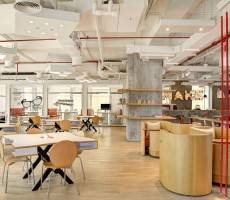 In Dubai, there are no suburban dinosaurs; those large-scale, single purpose office buildings that ignore the agile realities of modern working life. In the western world, these giants evolved on business parks, driven by the perceived benefits of having office workers agglomerated in order to achieve efficiency of communication and dissemination. The business practices and technologies that underpinned these buildings have evolved and improved and many are in the process of being re-purposed. Things happen on a grander scale in the Middle East where the mantra is “if the land-use doesn’t fit the land, make more land.” Here, the patterns of work and place have evolved differently from the west, and at a much faster pace with creeping tides of development spreading rapidly out from the small centres of traditional trade and commerce to vast tracts of new development.
In Dubai, there are no suburban dinosaurs; those large-scale, single purpose office buildings that ignore the agile realities of modern working life. In the western world, these giants evolved on business parks, driven by the perceived benefits of having office workers agglomerated in order to achieve efficiency of communication and dissemination. The business practices and technologies that underpinned these buildings have evolved and improved and many are in the process of being re-purposed. Things happen on a grander scale in the Middle East where the mantra is “if the land-use doesn’t fit the land, make more land.” Here, the patterns of work and place have evolved differently from the west, and at a much faster pace with creeping tides of development spreading rapidly out from the small centres of traditional trade and commerce to vast tracts of new development.
This process is driven by ambitious national programmes and an increasing awareness of the need to build a society that will endure and prosper long after the world’s dependence on the abundance and availability of fossil fuels has passed. For developers, this has meant wave after wave of semi-government and government estate developments, some founded on single-purpose development in the tradition of the Souq, leading to Dubai’s showcase projects of the early 2000’s – “Internet”, “Gold” “Media” and similar estates that were proclaimed “Cities” (only “Knowledge” is a “Village”).
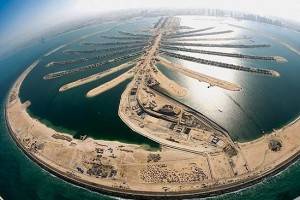 The logic and lifestyles of creating huge mixed use developments, both onshore and in colossal reclamation projects offshore, have seen various models of work and place evolve. Offshore reclamation projects have increased Dubai’s 1975 coastline by about 180km, adding (as of 2014) about 70km² of prime coastal land of which less than a fifth has been fully developed. The ultimate vision prior to the global economic crisis was to create more than 520 km of new coastline. Those plans have been scaled back, but not abandoned.
The logic and lifestyles of creating huge mixed use developments, both onshore and in colossal reclamation projects offshore, have seen various models of work and place evolve. Offshore reclamation projects have increased Dubai’s 1975 coastline by about 180km, adding (as of 2014) about 70km² of prime coastal land of which less than a fifth has been fully developed. The ultimate vision prior to the global economic crisis was to create more than 520 km of new coastline. Those plans have been scaled back, but not abandoned.
The hourglass shapes of the two Palms (Jumeirah & Jebel Ali) effectively funnel all access through a few narrow causeways, with travel distances of up to 16km just to reach the main coastal highway leading to other destinations. The City Metro that was completed just four years ago is already unable to cope with passenger numbers, even with trains running at 2-minute intervals at peak hours. A monorail runs the length of Palm Jumeirah, but terminates 1km short of a metro station and is hence used only by tourists and not by commuters. These disconnects arose as a result of the incredible pace of development, constantly changing aims and structure of the development authorities, and inability to coordinate all the changes in a very short space of time. Faced with commuting distances of more than 50km to central Dubai an alternative is required for places to work closer to home, or work practices that reduce the dependency on a daily commute.
Jumbo Caravanserai
The primary form of transport in Dubai is not the car – it is the aeroplane. Dubai has reinvented itself as a caravanserai at a major crossroads of global travel, a place that multitudes pass through that has become a destination in its own right. Dubai International toppled London Heathrow as the world’s busiest airport by international travellers in 2014. Passenger traffic at Dubai International and Al Maktoum International combined reached 71.3 million last year.
Traffic for the two airports is expected to exceed 126 million by 2020 and 200 million by 2030. The vast majority are on their way to somewhere else, but many stop over or commute to nearby Gulf states: passenger growth is averaging close to 10 percent annually. An extension of the Dubai Metro to link the two airports in time for Expo 202 has recently been announced.
All those planes mean work and revenue. Dubai Duty Free alone recorded annual sales of US$1.9 billion in 2014, expected to rise to US$2.1B in 2015. Add to that revenue from sister international airports in Abu Dhabi, Sharjah and the brand-new, 10-runway Dubai World Central Airport and you begin to appreciate what a driver travel and tourism is for the UAE economy. Around 75 percent of the population are expatriates, and all of them came by plane, will leave by plane, and make return trips to their home countries or a holiday destination on an annual basis. Work is spread across the region, as well as in town. On a typical day there are 65 flights on regional airlines between Dubai and Doha, just 375km away in neighbouring Qatar. Hundreds of passengers on those flights are business people, plying their trade in both countries. The face-to-face nature of business in the Middle East dictates that business transactions that could easily be managed over the internet are instead conducted over the length of a day, with six-hour travel and transfers on top.
Population grows, but traffic flows struggle to cope
Since 1975, Dubai’s population has grown from just over 200,000, mostly local citizens, to nearly 2.2 million, a tenfold increase in population and a shift in demographics to the point where UAE citizens are now outnumbered 4 to 1 in the urban centres, and for the most part they wouldn’t have it any other way – expatriate business and expenditure is what drives the economy.
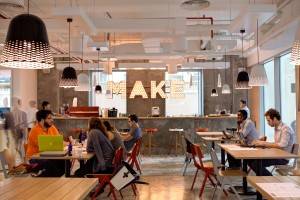
Make Business Hub in Dubai Marina (also main image)
Expatriates feel welcome here. “The National” daily newspaper reported in February 2013 that the most populous neighbourhood in the emirate was Muhaisnah 2, a labour camp area known as Sonapur, where there are more than 3,000 men for each woman. Muhaisnah 2 contains about 8 percent of Dubai’s population in 5.5 square kilometres. In residential suburban areas, populations are more evenly balanced, with 29 boroughs having a majority of females, but in far lower overall numbers.
For the UAE, immigrants are not a problem – they are a necessity, and they are made to feel welcome. Subject to local rules and guidelines, expats can own property (but not land), drink, smoke, dress immodestly, eat pork products bought in local supermarkets, educate their children in schools with their home country curriculae, get access to government sponsored healthcare services, attend church and commemorate Anzac Day in public. Generally speaking, expats don’t pay income tax, but pay as they go with rates and lifestyle choices. The UAE’s multicultural blend of ethnicities, faiths, religions and lifestyles works pretty well.
A peculiarity of the economy is that the armies of blue-collar workers remit 90 percent of their salaries to support families back in their home countries, whereas the higher-paid white-collar workers typically see the vast majority of their earnings allocated to the high costs of living and the luxury lifestyle that attracted them to Dubai in the first place.
Need more buildings? Make more land!
In the period from 2002 to date, the pressure to build and expand in Dubai has led to vast offshore reclamation projects – these have expanded the landmass offshore by almost the same area as developments onshore. In the boom years from 2003-2008, the map of Dubai was akin to an advent calendar – every couple of months, another swathe of the map would be lifted with the announcement of the release of another off-plan development, fuelled by a gold-rush mentality that saw properties changing hands numerous times at ever-increasing values, often before a sod had been turned.
The prevailing “build-to-sell” mentality led to commercial buildings being completed to shell & core stage, often years in advance of the infrastructure needed to make them viable. Some areas, with good controls and management, were resounding successes. The less scrupulous developers riding the coat-tails of the boom were left with buildings of only average quality with none of the requisites to attract companies amidst a glut of available office space.
Following the bust, many buildings were re-purposed, sometimes with disastrous results. High-rise buildings designed as apartments were converted to office use – successful in some, but in others the tenant loads on occupied floors meant that the domestic-capacity elevators could not cope with peak loads, leading to queues of office workers snaking out the lobby doors and into the streets.
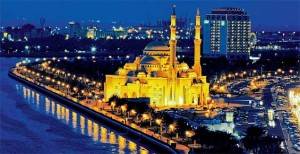
Sharjah
As many mid-level staff in offices and retail could not afford the rental premiums of living in Dubai, many preferred to locate in Sharjah, an adjacent emirate that did not have the roads infrastructure to cope with huge flows of cars back and forth every morning and evening. In 2006, before the roads infrastructure caught up with progress, it was not uncommon for residents of Sharjah to leave for work at 3:30am to beat the traffic, and sleep in their cars until it was time to start work.
For those living in Dubai’s offshore developments, given the option of long commutes to high-rise offices with expensive parking, or working off a handheld device from a villa, apartment or serviced business centre overlooking a beach, Dubai’s office workers of the future are going to opt for working close to home. With yet more reclamation still to come, the already overloaded Shaikh Zayed Road simply won’t be able to cope.
Large tract projects in Dubai’s hinterland are of equal magnitude – and there is no sign of slowing down
The Dubai Statistics Centre visitors estimated that there were 1,041,705 daily visitors to Dubai last year – people who travel for work, leisure or tourism but live elsewhere, up 2 percent from the previous year.
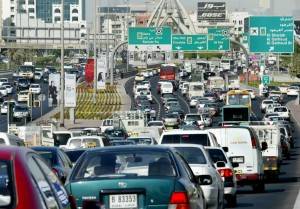
Every working day, vast tides of traffic clog the highways linking Abu Dhabi, Dubai and Sharjah. Tired workers face a nerve-wracking high-speed 150-200km commute each way on congested 8-lane highways with a legal maximum speed of 140kph, slowing to a crawl on the exit and arrival into each city. Accidents are frequent, adding to the risk, congestion, frustration and delays, reducing the effectiveness, efficiency and happiness of all those who face the daily slog.
The counterbalance to all this is an incredibly far-reaching long-term vision that allowed it all to happen in the first place, and a willingness to redevelop as necessary to ease pressure points of transportation and infrastructure. By 2050, Dubai and Abu Dhabi will be satellite cities feeding Kirzad Industrial City, the world’s largest fully computerised container-handling port and an associated industrial zone spread over 418KM² which straddles the main highway between Abu Dhabi and Dubai. This will become a hub for manufacturing, logistics and trade across a number of sectors, creating prosperity and a lasting legacy for future generations due to a pioneering mindset and a meticulous approach to planning and execution.
Agile working
Organisations nowadays are diverse communities of people strung together by technology for a common purpose; there is no longer such a pressing need for people to be in a common place to achieve that purpose, and the trend to the future will release people to work effectively in places that are not defined by structure, but by communication networks.
Signs of the end of the era of high oil prices are already at hand. In just a matter of months, the price of a barrel of oil dropped from more than $100 to about $70, and petrol is now cheaper than it has been in years. Customs of closely guarding information, mistrust of cloud computing, and unreliable internet services held back the onset of the agile workplace, however that is rapidly changing as global practices of e-commerce and communications become more widespread. The latest mobile phone and the trendiest app has become a must-have for locals and expats alike.
Qatar
The smaller, but richer, State of Qatar faces even greater problems of commuting and transportation. Having spent a couple of days gridlocked in Doha, Qatar, where the entire urban infrastructure is being ripped up and reconfigured for the 2022 World Cup, any measure that reduces what should be a 15 minute-max commute down from 90-120 minutes, each way, in any direction has to be a massive leap forward in productivity, worker satisfaction and stress reduction. Dubai was in the same position eight years ago, but now has urban corridors that drain the traffic to dormitory suburbs. Qatar’s ring roads create loops with no means of relief, and the urban centres of older European cities face the same problems. Mobility of information makes us less dependent on the inefficiencies of transportation.
Dubai never fails to excite
What does all this say about ‘conglomeration economics’ and quality of life? Commenting on the pace of development on a visit to the UAE in April 2013, Mayor of London, Boris Johnson, declared London an honorary member of the federation. “There are so many people from the UAE in the Knightsbridge and Mayfair areas that over the summer I have the honour to be the mayor of the eighth emirate.”
The unexpected outcome to all this is that Dubai has quite deliberately chosen a path of planned development that will sustain the economy in the post-oil era. Abu Dhabi is actually the home of the Federal UAE Government and the oil-rich emirate, as oil has never contributed more than 7 percent of Dubai’s GDP.
Many of Dubai’s new communities are well-planned, multi-faceted combinations of commercial, residential and retail facilities with extensive leisure, lifestyle and entertainment opportunities – none more so than the immensely successful conglomeration of Dubai International Financial Centre, the Burj Khalifa Precinct and Business Bay.
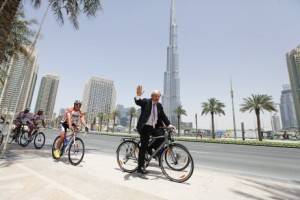 Multinationals have increasingly chosen to centre their regional operations in Dubai, and have the opportunity to introduce contemporary notions of work and place to their glittering HQ Buildings. Environmentally rated offices do not attract rental premiums as yet, but they are becoming the default standard for many companies and hence making the “dinosaurs” of more traditional buildings less attractive. Many smaller companies, my own included, have adopted agile work practices, working instead from locations that are convenient for ease of travel and closeness to clients for that all-important “face-time”.
Multinationals have increasingly chosen to centre their regional operations in Dubai, and have the opportunity to introduce contemporary notions of work and place to their glittering HQ Buildings. Environmentally rated offices do not attract rental premiums as yet, but they are becoming the default standard for many companies and hence making the “dinosaurs” of more traditional buildings less attractive. Many smaller companies, my own included, have adopted agile work practices, working instead from locations that are convenient for ease of travel and closeness to clients for that all-important “face-time”.
Boris Bikes are not the answer to the sweltering summers in the Middle East, however the future is likely to see better connectivity of urban clusters with more public transport, urban planning that reduces or eliminates the need to communicate, and systems of work and communications that replace the traditional practices of face-to-face communications.
This feature is taken from the current issue of Work&Place
________________________________________
Douglas Langmead
Douglas Langmead is CEO of Aptitude Management Services in Dubai, offering “Apt Information Technology, Urban Design and Environment”. He has designed more than 100 office fit outs in Bahrain and Dubai, as well as developing corporate asset management strategies for DHL throughout the region. An architect by vocation, Doug has lived and worked throughout the Middle East since 1979.
 He has worked in an executive capacity on many of the major projects of the past 3 decades, including the 42-tower Jumeirah Beach Residence at Dubai Marina, maritime projects, a World-Heritage listed public park in Oman and several palaces. Since striking out on his own in 2000, he has focussed on the development and use of tools and systems of information management to improve communications of diverse stakeholders in the construction and facilities management sectors, developing a binary model of the development cycle that connects the investment process of design and construction with the return on the investment that is realised prior to redevelopment. Having worked on design of offices for many of the major organisations in the region, Doug has a strong awareness of the difficulties commercial organisations face in the Middle East, as well as the opportunities for innovation. www.ptitude.com
He has worked in an executive capacity on many of the major projects of the past 3 decades, including the 42-tower Jumeirah Beach Residence at Dubai Marina, maritime projects, a World-Heritage listed public park in Oman and several palaces. Since striking out on his own in 2000, he has focussed on the development and use of tools and systems of information management to improve communications of diverse stakeholders in the construction and facilities management sectors, developing a binary model of the development cycle that connects the investment process of design and construction with the return on the investment that is realised prior to redevelopment. Having worked on design of offices for many of the major organisations in the region, Doug has a strong awareness of the difficulties commercial organisations face in the Middle East, as well as the opportunities for innovation. www.ptitude.com
References














June 25, 2015
Long distance commuting, agile working and dinosaur extinction in the UAE
by Douglas Langmead • Cities, Comment, Flexible working, Property
This process is driven by ambitious national programmes and an increasing awareness of the need to build a society that will endure and prosper long after the world’s dependence on the abundance and availability of fossil fuels has passed. For developers, this has meant wave after wave of semi-government and government estate developments, some founded on single-purpose development in the tradition of the Souq, leading to Dubai’s showcase projects of the early 2000’s – “Internet”, “Gold” “Media” and similar estates that were proclaimed “Cities” (only “Knowledge” is a “Village”).
The hourglass shapes of the two Palms (Jumeirah & Jebel Ali) effectively funnel all access through a few narrow causeways, with travel distances of up to 16km just to reach the main coastal highway leading to other destinations. The City Metro that was completed just four years ago is already unable to cope with passenger numbers, even with trains running at 2-minute intervals at peak hours. A monorail runs the length of Palm Jumeirah, but terminates 1km short of a metro station and is hence used only by tourists and not by commuters. These disconnects arose as a result of the incredible pace of development, constantly changing aims and structure of the development authorities, and inability to coordinate all the changes in a very short space of time. Faced with commuting distances of more than 50km to central Dubai an alternative is required for places to work closer to home, or work practices that reduce the dependency on a daily commute.
Jumbo Caravanserai
The primary form of transport in Dubai is not the car – it is the aeroplane. Dubai has reinvented itself as a caravanserai at a major crossroads of global travel, a place that multitudes pass through that has become a destination in its own right. Dubai International toppled London Heathrow as the world’s busiest airport by international travellers in 2014. Passenger traffic at Dubai International and Al Maktoum International combined reached 71.3 million last year.
Traffic for the two airports is expected to exceed 126 million by 2020 and 200 million by 2030. The vast majority are on their way to somewhere else, but many stop over or commute to nearby Gulf states: passenger growth is averaging close to 10 percent annually. An extension of the Dubai Metro to link the two airports in time for Expo 202 has recently been announced.
All those planes mean work and revenue. Dubai Duty Free alone recorded annual sales of US$1.9 billion in 2014, expected to rise to US$2.1B in 2015. Add to that revenue from sister international airports in Abu Dhabi, Sharjah and the brand-new, 10-runway Dubai World Central Airport and you begin to appreciate what a driver travel and tourism is for the UAE economy. Around 75 percent of the population are expatriates, and all of them came by plane, will leave by plane, and make return trips to their home countries or a holiday destination on an annual basis. Work is spread across the region, as well as in town. On a typical day there are 65 flights on regional airlines between Dubai and Doha, just 375km away in neighbouring Qatar. Hundreds of passengers on those flights are business people, plying their trade in both countries. The face-to-face nature of business in the Middle East dictates that business transactions that could easily be managed over the internet are instead conducted over the length of a day, with six-hour travel and transfers on top.
Population grows, but traffic flows struggle to cope
Since 1975, Dubai’s population has grown from just over 200,000, mostly local citizens, to nearly 2.2 million, a tenfold increase in population and a shift in demographics to the point where UAE citizens are now outnumbered 4 to 1 in the urban centres, and for the most part they wouldn’t have it any other way – expatriate business and expenditure is what drives the economy.
Make Business Hub in Dubai Marina (also main image)
Expatriates feel welcome here. “The National” daily newspaper reported in February 2013 that the most populous neighbourhood in the emirate was Muhaisnah 2, a labour camp area known as Sonapur, where there are more than 3,000 men for each woman. Muhaisnah 2 contains about 8 percent of Dubai’s population in 5.5 square kilometres. In residential suburban areas, populations are more evenly balanced, with 29 boroughs having a majority of females, but in far lower overall numbers.
For the UAE, immigrants are not a problem – they are a necessity, and they are made to feel welcome. Subject to local rules and guidelines, expats can own property (but not land), drink, smoke, dress immodestly, eat pork products bought in local supermarkets, educate their children in schools with their home country curriculae, get access to government sponsored healthcare services, attend church and commemorate Anzac Day in public. Generally speaking, expats don’t pay income tax, but pay as they go with rates and lifestyle choices. The UAE’s multicultural blend of ethnicities, faiths, religions and lifestyles works pretty well.
A peculiarity of the economy is that the armies of blue-collar workers remit 90 percent of their salaries to support families back in their home countries, whereas the higher-paid white-collar workers typically see the vast majority of their earnings allocated to the high costs of living and the luxury lifestyle that attracted them to Dubai in the first place.
Need more buildings? Make more land!
In the period from 2002 to date, the pressure to build and expand in Dubai has led to vast offshore reclamation projects – these have expanded the landmass offshore by almost the same area as developments onshore. In the boom years from 2003-2008, the map of Dubai was akin to an advent calendar – every couple of months, another swathe of the map would be lifted with the announcement of the release of another off-plan development, fuelled by a gold-rush mentality that saw properties changing hands numerous times at ever-increasing values, often before a sod had been turned.
The prevailing “build-to-sell” mentality led to commercial buildings being completed to shell & core stage, often years in advance of the infrastructure needed to make them viable. Some areas, with good controls and management, were resounding successes. The less scrupulous developers riding the coat-tails of the boom were left with buildings of only average quality with none of the requisites to attract companies amidst a glut of available office space.
Following the bust, many buildings were re-purposed, sometimes with disastrous results. High-rise buildings designed as apartments were converted to office use – successful in some, but in others the tenant loads on occupied floors meant that the domestic-capacity elevators could not cope with peak loads, leading to queues of office workers snaking out the lobby doors and into the streets.
Sharjah
As many mid-level staff in offices and retail could not afford the rental premiums of living in Dubai, many preferred to locate in Sharjah, an adjacent emirate that did not have the roads infrastructure to cope with huge flows of cars back and forth every morning and evening. In 2006, before the roads infrastructure caught up with progress, it was not uncommon for residents of Sharjah to leave for work at 3:30am to beat the traffic, and sleep in their cars until it was time to start work.
For those living in Dubai’s offshore developments, given the option of long commutes to high-rise offices with expensive parking, or working off a handheld device from a villa, apartment or serviced business centre overlooking a beach, Dubai’s office workers of the future are going to opt for working close to home. With yet more reclamation still to come, the already overloaded Shaikh Zayed Road simply won’t be able to cope.
Large tract projects in Dubai’s hinterland are of equal magnitude – and there is no sign of slowing down
The Dubai Statistics Centre visitors estimated that there were 1,041,705 daily visitors to Dubai last year – people who travel for work, leisure or tourism but live elsewhere, up 2 percent from the previous year.
Every working day, vast tides of traffic clog the highways linking Abu Dhabi, Dubai and Sharjah. Tired workers face a nerve-wracking high-speed 150-200km commute each way on congested 8-lane highways with a legal maximum speed of 140kph, slowing to a crawl on the exit and arrival into each city. Accidents are frequent, adding to the risk, congestion, frustration and delays, reducing the effectiveness, efficiency and happiness of all those who face the daily slog.
The counterbalance to all this is an incredibly far-reaching long-term vision that allowed it all to happen in the first place, and a willingness to redevelop as necessary to ease pressure points of transportation and infrastructure. By 2050, Dubai and Abu Dhabi will be satellite cities feeding Kirzad Industrial City, the world’s largest fully computerised container-handling port and an associated industrial zone spread over 418KM² which straddles the main highway between Abu Dhabi and Dubai. This will become a hub for manufacturing, logistics and trade across a number of sectors, creating prosperity and a lasting legacy for future generations due to a pioneering mindset and a meticulous approach to planning and execution.
Agile working
Organisations nowadays are diverse communities of people strung together by technology for a common purpose; there is no longer such a pressing need for people to be in a common place to achieve that purpose, and the trend to the future will release people to work effectively in places that are not defined by structure, but by communication networks.
Signs of the end of the era of high oil prices are already at hand. In just a matter of months, the price of a barrel of oil dropped from more than $100 to about $70, and petrol is now cheaper than it has been in years. Customs of closely guarding information, mistrust of cloud computing, and unreliable internet services held back the onset of the agile workplace, however that is rapidly changing as global practices of e-commerce and communications become more widespread. The latest mobile phone and the trendiest app has become a must-have for locals and expats alike.
Qatar
The smaller, but richer, State of Qatar faces even greater problems of commuting and transportation. Having spent a couple of days gridlocked in Doha, Qatar, where the entire urban infrastructure is being ripped up and reconfigured for the 2022 World Cup, any measure that reduces what should be a 15 minute-max commute down from 90-120 minutes, each way, in any direction has to be a massive leap forward in productivity, worker satisfaction and stress reduction. Dubai was in the same position eight years ago, but now has urban corridors that drain the traffic to dormitory suburbs. Qatar’s ring roads create loops with no means of relief, and the urban centres of older European cities face the same problems. Mobility of information makes us less dependent on the inefficiencies of transportation.
Dubai never fails to excite
What does all this say about ‘conglomeration economics’ and quality of life? Commenting on the pace of development on a visit to the UAE in April 2013, Mayor of London, Boris Johnson, declared London an honorary member of the federation. “There are so many people from the UAE in the Knightsbridge and Mayfair areas that over the summer I have the honour to be the mayor of the eighth emirate.”
The unexpected outcome to all this is that Dubai has quite deliberately chosen a path of planned development that will sustain the economy in the post-oil era. Abu Dhabi is actually the home of the Federal UAE Government and the oil-rich emirate, as oil has never contributed more than 7 percent of Dubai’s GDP.
Many of Dubai’s new communities are well-planned, multi-faceted combinations of commercial, residential and retail facilities with extensive leisure, lifestyle and entertainment opportunities – none more so than the immensely successful conglomeration of Dubai International Financial Centre, the Burj Khalifa Precinct and Business Bay.
Boris Bikes are not the answer to the sweltering summers in the Middle East, however the future is likely to see better connectivity of urban clusters with more public transport, urban planning that reduces or eliminates the need to communicate, and systems of work and communications that replace the traditional practices of face-to-face communications.
This feature is taken from the current issue of Work&Place
________________________________________
Douglas Langmead
Douglas Langmead is CEO of Aptitude Management Services in Dubai, offering “Apt Information Technology, Urban Design and Environment”. He has designed more than 100 office fit outs in Bahrain and Dubai, as well as developing corporate asset management strategies for DHL throughout the region. An architect by vocation, Doug has lived and worked throughout the Middle East since 1979.
References